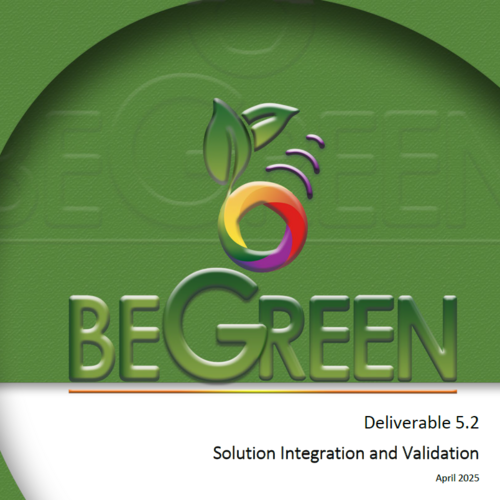D5.2 - Solution Integration and Validation
About
BeGREEN D5.2 takes the definitions and plans in BeGREEN D5.1 [1] and reports the design and implementation of the testbeds to deliver the proof-of-concepts (PoCs) and associated measurements. An integration plan is defined, including timescales and agreed interfaces, and the use cases and their integration onto the testbeds in readiness for final demonstration and testing.
The document initially provides details of the testbeds that will be used for the PoCs, and the description of the final BeGREEN demonstration.
This deliverable provides additional details of the PoCs, including descriptions, associated use cases (reference to use cases defined in BeGREEN D2.1 [6] and BeGREEN D2.2 [7]), and a high-level plan for each PoC implementation and a description of the BeGREEN final demonstration is provided, identifying PoCs that are going to be presented. BeGREEN PoCs described in this document are the following:
• PoC1: BeGREEN Intelligence Plane; that is one of the main components of the BeGREEN architecture. Its main functionality is to expose Artificial Intelligence (AI)/Machine Learning (ML) functions to rApps and xApps, enabling the creation of intelligent closed-loop automation empowered by AI/ML, aiming at improving energy efficiency (EE). Its features will be tested by including it in different PoCs, and at least one AI/ML-based rApp/xApp targeting EE at the RAN will be showcased.
• PoC2: Sensing assisted communications using a Reconfigurable Intelligent Surface (RIS); The sensing-assisted communications PoC aims to demonstrate how user positioning data coming from sensing services can be used for energy savings in future mobile networks. The main idea of the demo is to dynamically change the reflection properties of a RIS depending on the potential user location. Additionally, this data can be fed into the network and used for optimization of network resource allocation.
• PoC3: Energy efficient CU and O-RAN RIC; This PoC will provide an alternative implementation (acceleration) of CU and O-RAN RIC based on ARM architecture to demonstrate enhanced performance and reduce energy consumption in these components.
• PoC4: Energy-efficient DU implementation using hardware (HW) acceleration; This PoC is on implementation of DU high-PHY algorithms, using HW acceleration techniques, to reduce power consumption compared to legacy implementation. Specific targets are Low Density Parity Check (LDPC) decoder and sphere decoder.
• PoC5: RU power amplifier (PA) blanking; This PoC is on a RU power consumption optimisation technique called “PA blanking”. The PA blanking algorithm reduces the RU power consumption by turning off (blanking) the RF PA, which is the highest power-hungry component in the RU (especially in high power RUs > 1 Watt) at times when there is no data to be transmitted by the RU.
The outline of the Key Performance Indicators (KPIs) that each PoC will cover, which is based on the KPIs defined in the Description of Work (DoW) and augmented in BeGREEN D2.2. The initial set of measurement results stemming from the PoCs are provided as well. Finally, the risks associated to the implementation and deployment of the PoCs infrastructure are updated and justified appropriately.
Editor
Simon Pryor, German Castellanos (ACC)





